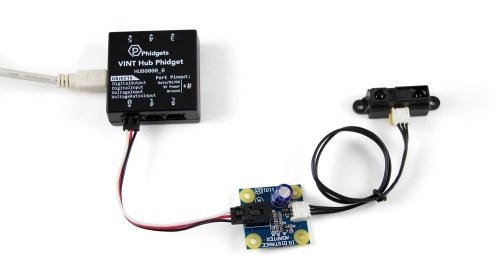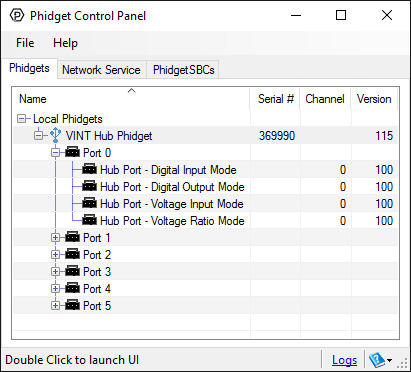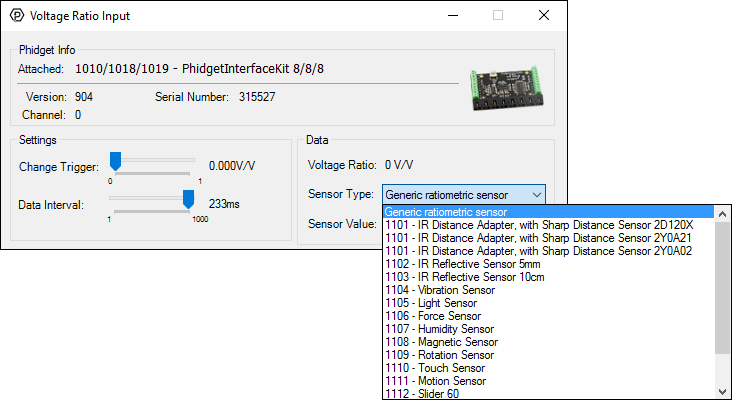1101 User Guide
Getting Started
Welcome to the 1101 user guide! In order to get started, make sure you have the following hardware on hand:
- 1101 - IR Distance Adapter
- Any Phidget with a Voltage Ratio Input port, here are some compatible products. We will be using the VINT Hub for this guide.
- USB cable and computer
- Phidget cable
- Sharp distance sensor
Next, you will need to connect the pieces:

- Connect the Sharp distance sensor to the 1101.
- Connect the 1101 to the HUB0000 using the Phidget cable.
- Connect the HUB0000 to your computer using the USB cable.
Now that you have everything together, let's start using the 1101!
Using the 1101
Phidget Control Panel
In order to demonstrate the functionality of the 1101, we will connect it to the HUB0000, and then run an example using the Phidget Control Panel on a Windows machine.
The Phidget Control Panel is available for use on both macOS and Windows machines. If you would like to follow along, first take a look at the getting started guide for your operating system:
Linux users can follow the getting started with Linux guide and continue reading here for more information about the 1101.
First Look
After plugging in the 1101 into the HUB0000, and the HUB0000 into your computer, open the Phidget Control Panel. You will see something like this:

The Phidget Control Panel will list all connected Phidgets and associated objects, as well as the following information:
- Serial number: allows you to differentiate between similar Phidgets.
- Channel: allows you to differentiate between similar objects on a Phidget.
- Version number: corresponds to the firmware version your Phidget is running. If your Phidget is listed in red, your firmware is out of date. Update the firmware by double-clicking the entry.
The Phidget Control Panel can also be used to test your device. Double-clicking on an object will open an example.
Voltage Ratio Input
Double-click on a Voltage Ratio Input object in order to run the example:

General information about the selected object will be displayed at the top of the window. You can also experiment with the following functionality:
- Modify the change trigger and/or data interval value by dragging the sliders. For more information on these settings, see the data interval/change trigger page.
- Select the 1101 from the Sensor Type drop-down menu. The example will now convert the voltage into distance (cm) automatically. Converting the voltage to distance (cm) is not specific to this example, it is handled by the Phidget libraries, with functions you have access to when you begin developing!
Technical Details
General
The function of the 1101 is to regulate the power requirement of the connected Sharp distance sensor, smoothing out current spikes that could otherwise overwhelm the device measuring them.
Make sure that the distance of the object being measured is within the distance range of the sensor. When the object is outside the valid sensor's distance range, the returned value should be discarded. You must be especially careful when the object is closer than it should be, as the returned value might be within the expected voltage range but is not meaningful. If the sensor is being used outdoors, be mindful that sunlight can cause interference, especially when the sunlight is entering at such an angle that it is within the sensor's cone of detection. The IR light from these sensors can pass through glass, but only if the glass is completely clear and the sensor is perpendicular and very close to the surface of the glass. Otherwise, too much IR light will be reflected for the sensor to work properly.
Formulas
The Phidget libraries can automatically convert sensor voltage into distance (cm) by selecting the appropriate SensorType. See the Phidget22 API for more details. These formulas are derived from the Sharp datasheets to compute distance and are only valid for the Sharp distance sensors we sell.
The formula to translate voltage ratio into Distance for Sharp 4-30cm analog sensor is:
- This formula is only valid for VoltageRatio between 0.08 and 0.53.
The formula to translate voltage into Distance for Sharp 10-80cm analog sensors is:
- This formula is only valid for VoltageRatio between 0.08 and 0.53.
The formula to translate voltage into Distance for Sharp 20-150cm analog sensors is:
- This formula is only valid for VoltageRatio between 0.08 and 0.49.
Note: The output of this sensor will vary from unit to unit, and based on the characteristics of the target (reflectance, size, direction of motion, object alignment, etc). Our formula is based on the data provided by Sharp. If you find that you are not getting good results with the standard formulas, you may want to derive your own formula to better characterize your situation.
Compatible Infrared Sensors
The following is a list of distance sensors that are known to work with the IR Distance Adapter Board. If the product is not listed here, it can be assumed to be incompatible.
| Manufacturer | Part Number | Description |
| Sharp | GP2Y0A02YK0F | 20-150cm Analog |
| Sharp | GP2Y0A02YK | 20-150cm Analog (non-RoHS) |
| Sharp | GP2Y0D21YK0F | 24cm Digital |
| Sharp | GP2Y0D21YK | 24cm Digital (non-RoHS) |
| Sharp | GP2D14J0000F | 24cm Digital |
| Sharp | GP2D15 | 24cm Digital (non-RoHS) |
| Sharp | GP2Y0D02YK0F | 80cm Digital |
| Sharp | GP2Y0D02YK | 80cm Digital (non-RoHS) |
| Sharp | GP2D150AJ00F | 15cm Digital |
| Sharp | GP2D140A | 15cm Digital (non-RoHS) |
| Sharp | GP2Y0A21YK0F | 10-80cm Analog |
| Sharp | GP2D12 | 10-80cm Analog (non-RoHS) |
| Sharp | GP2Y0A21YK | 10-80cm Analog (non-RoHS) |
| Sharp | GP2D120XJ00F | 4-30cm Analog |
| Sharp | GP2D120 | 4-30cm Analog (non-RoHS) |
Phidget Cable

The Phidget Cable is a 3-pin, 0.100 inch pitch locking connector. Pictured here is a plug with the connections labelled. The connectors are commonly available - refer to the Analog Input Primer for manufacturer part numbers.
What to do Next
- Programming Languages - Find your preferred programming language here and learn how to write your own code with Phidgets!
- Phidget Programming Basics - Once you have set up Phidgets to work with your programming environment, we recommend you read our page on to learn the fundamentals of programming with Phidgets.



